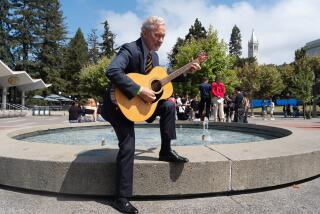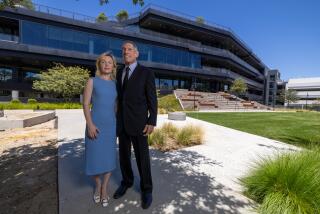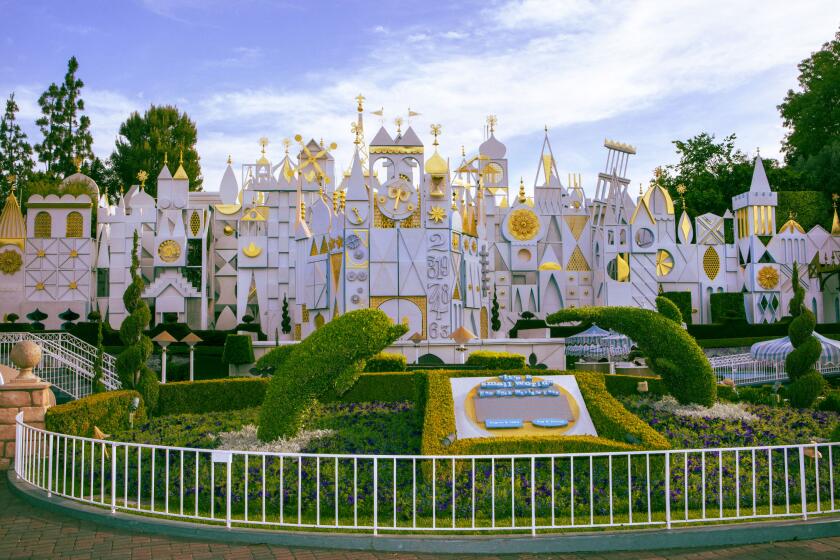UC Santa Barbara gets $50-million gift from Oracle chairman
- Share via
UC Santa Barbara, according to old stereotypes, may still conjure up the image of a lush campus by the beach, where students can squeeze in a few hours of surfing after class and live in a nearby neighborhood that is one of the nation’s best-known party zones. But in reality, UC Santa Barbara over the last three decades increasingly has become a center of scientific research, and its move in that direction was strengthened Saturday with the announcement of a $50-million private donation to energy efficiency research and engineering programs.
The gift is the largest in the history of UC Santa Barbara and is from Jeffrey Henley, who is chairman of the board of software giant Oracle and graduated from the college in 1966. About half the money will help construct a building to house the Institute for Energy Efficiency, an interdisciplinary research center that looks at such things as light bulbs that use less electricity and how to transmit Internet data with less heat. The rest will support engineering programs in other ways.
Henley, 67, said he and his wife, Judy, want their donation not only to support such research but also to set an example of private giving at a time when the 10-campus UC faces severe economic problems because of cutbacks in state funding.
“I’m a product of it and I love it,” he said of the University of California system. “People like myself have to step up more and more to help the UC system. It’s one of the remaining crown jewels of California and is a great economic engine for California and the United States. We can’t let it deteriorate or stand still.”
Henley also said in a telephone interview Saturday that he hoped the public’s perception of UC Santa Barbara as just a fun campus would come to match the reality of a school that has five Nobel laureates on its faculty in such disciplines as physics, chemistry, electrical engineering and economics.
The campus was strongly ranked in the National Research Council’s most recent survey of research doctoral programs, placing first in the country in materials sciences based on a compilation of scores in various categories. Its total scores for chemical engineering placed it third, after Caltech and UC Berkeley, and its electrical engineering department was fifth, after Harvard, Princeton, Stanford and Caltech.
UC Santa Barbara Chancellor Henry T. Yang noted that the campus, which enrolls about 19,000 undergraduates and 3,000 graduate students, is proud of its oceanside location and the fact that “our students are very happy here and have a lot of fun on weekends and evenings.” He said he expected the Henleys’ gift would bring more attention to the school’s academic reputation and further “enhance the quality of research and teaching.”
Of the Henleys’ total pledge, $25 million upfront will help finance a new building, which will be named Henley Hall and will house the Institute for Energy Efficiency, and $5 million will be for recruiting and retaining institute faculty. The university needs to raise an additional $25 million for the building.
Rounding out their gift, the Henleys have pledged $20 million to be paid from their estate at a later date to support the College of Engineering, including faculty recruitment, graduate student support and equipment.
Although the Henleys’ gift is far from the largest in the UC system’s history, it is a significant boost to UC Santa Barbara’s campaign to finish raising $1 billion in donations in the next four or five years. Including the new donation, the campus has $718 million in hand or pledged, officials said.
The new building will be designed to be a model of efficiency in heating, cooling and lighting even as the work inside strives for further advances in those areas, according to John Bowers, a professor of electrical and computer engineering who is director of the 3-year-old Institute for Energy Efficiency.
For example, he said, if teleconferencing becomes more efficient, that could lead people to drive less to attend meetings, thereby reducing pollution. “We waste more energy than we consume, but with scientific and technological breakthroughs we can change that — permanently,” said Bowers.
UC Santa Barbara hopes to add about 5,000 students to its rolls over the next 15 years, if it wins the California Coastal Commission’s approval for construction plans and finds enough funding, according to Yang.
The demand for enrollment there is strong, according to the UC admissions office. UC Santa Barbara received 54,831 applications for freshman admission next fall, making it the fourth-most popular of the nine UC undergraduate campuses; UCLA, UC Berkeley and UC San Diego attracted the most applications. UC Santa Barbara offered admission to about 43% of its applicants, about twice the percentages of the more competitive UCLA and UC Berkeley.
larry.gordon@latimes.com
More to Read
Sign up for Essential California
The most important California stories and recommendations in your inbox every morning.
You may occasionally receive promotional content from the Los Angeles Times.











